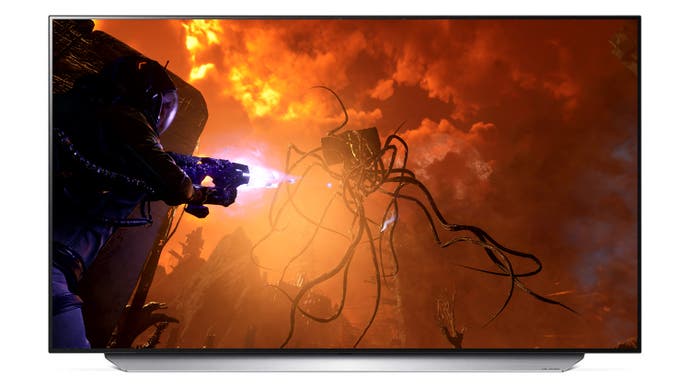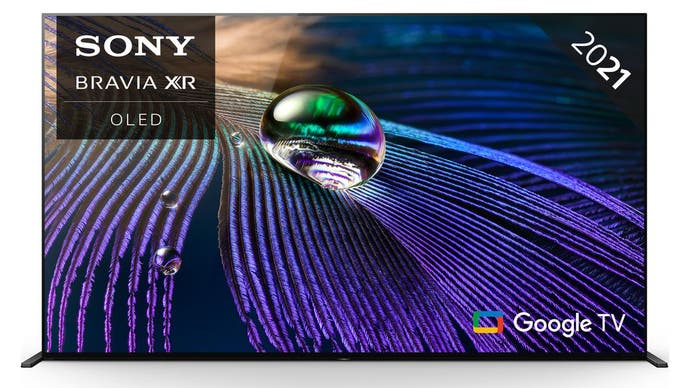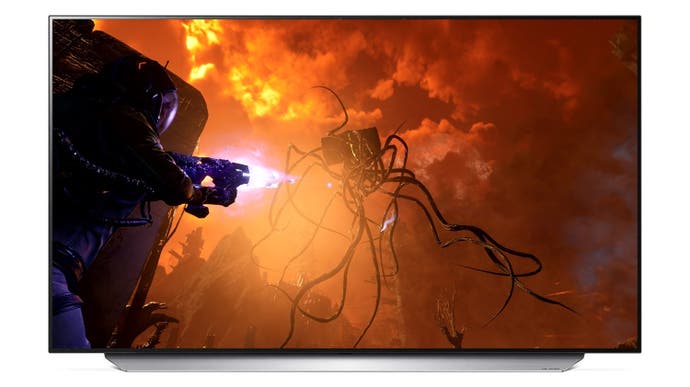The best 4K TVs for HDR gaming 2023 on PS5, Xbox Series X and PC
From entry-level champs to the best high-end OLED and QLED sets.
You could argue that as much as 2022 was a good year for gaming TVs, that 2023 is going to be even better. We've got everything from OLED to QLED and now QD-OLED choices, the 2022 models of which are coming down in price as the latest choices from the likes of LG, Samsung and Sony are on the way. 4K 120Hz TVs have become the de facto standard, and it's now possible to find great HDMI 2.1 sets at a range of prices.
Apart from making our 4K TV recommendations for gaming and movies, we'll also let you know which features are in the pipeline and what you can expect from gaming TVs over the next year. We'll also give a quick rundown of the four major panel types used in 4K HDR TVs - OLED, QLED, VA and IPS - so you have a basic idea of what their typical strengths and weaknesses are, in case you're considering a TV that isn't on this list.
So these are our top recommendations for gaming-friendly 4K HDR televisions in 2023, with more budget and mid-range options coming as we can test them. Use the quick links below to skip ahead, or read on for the full selections.
- Best 4K TV for HDR gaming
- Best premium 4K TV for HDR gaming
- Best QLED 4K TV for HDR gaming
- Best mid-range 4K TV for HDR gaming
LG C2/C1/CS OLED: the best 4K TVs for HDR gaming

- Specs: 48, 55, 65, 77 or 83 inches. HDMI 2.1. HDMI VRR, FreeSync and G-Sync Compatible. DolbyVision.
The best 4K TVs for HDR gaming are LG's recent OLEDs, the C1, CS and C2. They're built around panels from LG Display, providing incredible contrast, unparalleled pixel response times and gorgeous colour reproduction. The C1 is our top pick as it supports Black Frame Insertion (BFI) up to 120Hz, an option that boosts the clarity of fast-moving objects, while the CS and C2 only support this up to 60Hz. However, the C2 offers a brighter Evo panel, which may well be more impactful if you don't regularly use the BFI feature!
No matter whether you go for the 2021 C1, 2022 C2 or the CS hybrid (that packs C1 internals into a C2 chassis), you can expect great variable refresh rate support including HDMI VRR for consoles and FreeSync/G-Sync for PC users. This delivers smooth motion from 40Hz to 120Hz without tearing, judder or excessive input lag.
These LG OLEDs have four HDMI 2.1 ports, allowing for 4K 120fps gaming using a single cable on the PlayStation 5, Xbox Series X and current-gen PC graphics cards. Input lag is also extremely low, more akin to a high-end gaming monitor than a traditional 4K TV, making LG's OLEDs a great choice even for competitive gaming.
4K HDR content is where these TVs sing, but the television also handles lower-resolution content with aplomb thanks to excellent upscaling and full OSSC and Framemeister compatibility for retro gaming. LG's webOS software is also arguably the best available, thanks to a responsive interface that includes easy Wiimote-style selection and rapid multitasking.
Pros
- Four HDMI 2.1 ports allow 4K 120fps gaming on Series X, PS5 and next-gen GPUs
- Extremely low input latency when using gaming modes
- 120Hz black frame insertion enables better motion processing (C1 only)
- Unbeatable contrast, pixel response times, colour accuracy and viewing angles
- Excellent scaling for lower-resolution sources
Cons
- DolbyVision and HDR10 are supported, but HDR10+ is missing
- Burn-in possible, albeit extremely unlikely if you watch varied content
- No option for filter-free 720p or 1080p upscaling
- BFI limited to 60Hz on LG C2/CS models
Sony A90J: the best premium 4K TV for HDR gaming

- Specs: 55, 65 or 83 inches. HDMI 2.1. DolbyVision.
The Sony A90J is a very interesting proposition - an extremely expensive OLED that combines one of LG's new second-generation panels with Sony's excellent motion handling algorithms. The result is a TV that looks gorgeous in motion, with noticeably higher peak brightness than other OLEDs on the market, but there are downsides beyond the significantly higher price. VRR support was added in a software update, but it doesn't support FreeSync for AMD GPUs and G-Sync on Nvidia GPUs may exhibit issues, making this a poor choice for PC use - consider instead the newer A90K. Input lag is also slightly higher than it is on the LG C1, although at 16ms for 60Hz content it is still competitive.
Elsewhere, Sony has gotten a lot right. Motion handling is superb, as usual, and you get the usual OLED benefits - near-instant pixel response times, perfect blacks, infinite contrast, wide viewing angles and excellent colour reproduction. You also get the usual drawback - the potential for permanent image retention or burn-in, although as with other modern OLEDs this is unlikely if you vary the sort of content you use the TV with (eg you don't watch the same channel for dozens of hours consecutively) and you keep the default safeguards engaged (including features that reduce the brightness of static elements, shift the image by a pixel and refresh the screen when it's turned off).
If you're lucky enough to be working with a large budget, or no budget at all, the Sony A90J makes an excellent case for being the best 4K TV in the world. It only misses out on our top recommendation from some limitations in its gaming toolset (only two HDMI 2.1 ports, slightly higher input lag, no VRR yet) and its high price.
Pros
- Extremely bright for an OLED, thanks to LG's second-gen OLED evo panel
- Excellent motion handling with 120Hz Black Frame Insertion (BFI)
- Two HDMI 2.1 ports allow 4K 120fps gaming on Series X, PS5 and recent GPUs
- It's an OLED: perfectly deep blacks, wide viewing angles, fast pixel response times
Cons
- Slightly higher input lag than the LG C1, at 16ms (60Hz) or 12ms (120Hz)
- DolbyVision and HDR10 are supported, but HDR10+ is missing
- Burn-in remains a possibility, as this is an OLED panel
Samsung QN95B / QN90B: best QLED 4K TVs for HDR gaming

- Specs: 50, 55, 65 or 75 inches. HDMI 2.1. HDMI VRR and FreeSync. HDR10+.
The QN95B and QN90B are Samsung's flagship 4K TVs for 2022, incorporating a 'QLED Neo' screen with Mini LED backlighting. This allows for much better brightness (2000 nits in HDR) and better full array local dimming performance than previous models. As with previous QLED screens, the Neo screens are based around a VA panel which provides excellent contrast (3500:1 without local dimming, 110K:1 with), decent viewing angles and truly impressive out-of-the-box colour reproduction. Motion clarity and contrast aren't quite as good as an OLED, but these models can get far brighter than an OLED can and aren't vulnerable to burn-in either. HDR films and games look great here thanks to the colour reproduction and high peak brightness, and there's support for HDR10, HDR10+ and HLG - but no DolbyVision.
For gaming, the QN95B/QN90B have HDMI 2.1 support on all four ports, unlike their 2021 predecessors, including auto low latency mode (ALLM) and VRR (variable refresh rate). Input lag is low, at around 10ms at 60Hz and 5ms at 120Hz. The Black Frame Insertion (BFI) feature works up to 120Hz to reduce motion blur, which can be great for fast-paced games. As well as HDMI Forum VRR, the QN90B and QN95B also support FreeSync and G-Sync technologies, so it'll work great with PCs with Nvidia or AMD graphics cards.
The QN95B also works up to 144Hz on PC, providing a touch better responsiveness; this and the OneConnect box for inputs represent the only real differences between the QN95B and QN90B.
Pros
- Support for 4K 120Hz on all four ports
- Extremely low input lag in game mode
- Good motion handling with black frame insertion
- Variable refresh rate support for Xbox and PCs
- No risk of burn-in
Cons
- Black levels and viewing angles don't quite compare to OLED
- No DolbyVision support, although HDR10 and HDR10+ are supported
Sony X90K: Best mid-range 4K TV for HDR gaming

- Specs: 55, 65, 75 or 85 inches. HDMI 2.1. HDMI VRR. DolbyVision.
The Sony X90J is an excellent choice for next-gen gaming, with two HDMI 2.1 ports suitable for gaming at 4K 120Hz on the PS5, Xbox Series X and next-gen PC graphics cards. The X90K distinguishes itself with reasonably low input lag (~18ms at 60Hz and ~10ms at 120Hz), excellent contrast (35K:1 with full array local dimming, 7500:1 native) and strong colour accuracy. As with other VA panels, viewing angles are relatively narrow but peak brightness is more than respectable (580 nits in SDR, around 780 nits in HDR). As this isn't an OLED, there's no chance of burn-in. The X90K runs Google TV, which is responsive to navigate and boasts a deep app library.
Pros
- Very low input lag, VRR and two HDMI 2.1 ports
- Great motion handling with fast response times
- Impressive contrast ratio and excellent brightness
Cons
- Narrow viewing angles due to the VA panel used
- No FreeSync support for PC gaming
What do you look for in a good gaming TV?
For gaming, arguably one of the most important things to look for is input latency, and how low that figure is. It's a measure of how long it takes for your buttons presses to translate into in-game actions. Many of the best 4K HDR TVs offer input latency figures of below 12ms, but can go lower with the introduction of VRR tech, too, so you can get the snappiest inputs possible. For reference, the average for response time is 20ms, while slower screens react in 30ms or more. While it may not sound like a lot, it can be noticeable when you're looking for it.
Apart from input latency, we also think a TV's motion handling is integral, as well as which HDR formats they support and how vivid and well-presented their colours are. As well as this, we'll also take a gander at their built-in smart TV OS and how intuitive that is to use, too. In terms of pricing, we've seen the pricing of sets come down dramatically in the last year. For instance, a 55 inch OLED display will run you about £1000/$1000, while LCD models can cost a lot less than half that amount. To add to this, there are also even cheaper options that provide relatively poor HDR but still deliver a lot of screen for the money.
HDMI 2.1 connectivity is another important feature we're looking out for. This standard allows for both 8K 60Hz and 4K 120Hz content, bringing a massive boost to either resolution or responsiveness. HDMI 2.1 is an integral part of both the next-gen consoles and next-gen graphics cards, so it's worth looking for if you're buying a TV - especially a high-end option. We've recently rounded up all the 120fps PS5 and Xbox Series X/S games, including upcoming and backwards compatible titles.
Is it a good time to buy?
As we mentioned in the intro, it's a great time to upgrade to a new TV, as major HDR standards have emerged and best-in-class OLED TVs have become more affordable than ever. 2022 model year televisions are now being discounted as 2023 TVs are soon to be announced, so this is a good window to snag a bargain!
TV prices have stabilised somewhat, as the world's supply chains are seemingly on the mend following the global human malware epidemic, but cost of living, wars and trade disagreements are unfortunately a reality that many of us need to contend with. Regardless, if you need a nice TV to block out the world outside, then it might still be worth picking one up - but do consider prior-year models as sets from 2019 onwards could have the necessary features outlined below and cost far less than current-year models.
One of the most important techs you'll want to look out for when buying a TV is the inclusion of HDMI 2.1, a video standard standard that includes support for higher resolutions at higher frame-rates than ever before, including 8K 60Hz and 4K 120Hz support. As well as more raw data throughput, the new standard also includes features designed for gamers, like automatic low latency mode (ALLM), which automatically engages a game mode when a game is launched. Another important one is HDMI Forum variable refresh rate (VRR), which removes judder and makes small frame-rate drops less noticeable, without the heavy input lag penalty of traditional v-sync. Some TVs support parts of these standard with HDMI 2.0b ports, eg TVs with 60Hz panels may support VRR, ALLM and eARC without needing to support a 4K 120Hz connection. In general though, if you're considering a four figure TV, HDMI 2.1 support should be a given.
Display types
With the death of plasma displays, there are two major display types used in modern displays: LCD and OLED, with LCD representing the lower and mid-range of the market and OLED the high-end. LCD displays can be broken down further too, into IPS, VA and QLED displays. Here's what you need to know about each one, in order from cheapest to most expensive.
IPS: These monitors provide good viewing angles and improved colour accuracy compared to monitors using VA panels. However, some IPS panels, particularly older ones, can suffer from slower response times, making them worse for fast-paced games. Another potential issue is 'IPS glow', where the monitor's backlight is visible in dark scenes.
VA: A type of monitor panel which tends to occupy a middle-ground between IPS and cheap TN displays in many respects. These panels generally offer the best contrast, backed with good response times and colour reproduction. However, viewing angles and colour gamut may be limited compared to IPS and OLED.
QLED: This confusingly-named panel type from Samsung is essentially a VA panel that has been upgraded with quantum dots, allowing the monitors to produce slightly wider viewing angles than standard VA panels, plus higher brightness levels and wider colour gamuts. However, as is typical for a VA display, motion handling can be subpar.
OLED: This high-end display tech uses organic light-emitting diodes which produce what is arguably the best picture. Contrast is a strong suit, as individual pixels can be turned off completely to create a true black, rather than the very dark grey that other monitor types can produce. Viewing angles are also impressive, ensuring the picture from a 45-degree angle looks as good as the screen viewed dead-on. HDR is also well catered for, thanks to the ability to see extremely light and dark areas side-by-side. However, OLED can be expensive, its brightness can't compete with traditional LCDs and motion handling can be poor on some models. Image retention or burn-in is also a concern, although real-life OLED burn-in tests that have been running non-stop for several years show that image retention is unlikely to occur through normal use, even when gaming.
Common terms
Resolution: How many pixels are on screen, given as horizontal x vertical. 1920x1080 (1080p) and 3840x2160 (4K) are the most common resolutions for both TVs and monitors. The higher the resolution, the crisper and more detailed a game tends to look.
Refresh rate: How many times the screen updates per second, given in Hz. Standard TVs refresh at 60Hz, while more modern TVs can achieve 120Hz at some resolutions. For 4K at 120Hz, a TV needs to support the HDMI 2.1 standard. The higher the refresh rate, the more fluid a game will feel.
Response time: This stat typically measures how fast a pixel can turn from grey to white and then back to grey again. The best displays sport pixel response time figures of less than 4ms, with TN and fast IPS panels offering a quoted 1ms GtG and VA and regular IPS screens likely to achieve higher figures. OLED displays can achieve near-instant response times. Low response times help to eliminate distracting smears in fast-paced scenes. Note that response time is distinct from input lag, which refers to the delay between an input (like pressing a button) and seeing the effect of the input on-screen.
Contrast ratio: Simply the ratio between the brightness of a display when it is displaying perfect black versus perfect white. Around 1000:1 is typical for an IPS display, a VA display can hit 3000:1 or higher and an OLED has technically infinite contrast, as its organic LEDs can switch off entirely to create a completely dark image. High contrast ratio screens look particularly good in dark rooms, as blacks will appear properly black rather than dark grey. When a high contrast display also has high peak brightness levels (eg 600 nits and up), HDR content will look punchier too.
HDMI VRR, G-Sync and FreeSync: These terms refer to adaptive sync technology, designed to eliminate ugly screen-tearing and judder while adding less input lag than traditional v-sync. G-Sync is Nvidia's implementation and FreeSync is the AMD alternative, while HDMI VRR is a slightly more neutral standard implemented by the HDMI Forum with HDMI 2.0b and HDMI 2.1. A TV can support one, some or all of these standards.
HDR: High Dynamic Range allows for greater contrast between the lightest and darkest parts of an image, as well as a wider colour gamut. There are various video formats that go beyond vanilla HDR10, including DolbyVision, DisplayHDR 400/600/1000/1400 and HLG. Some videos will only be offered in a certain format, while others may be available in multiple formats. Choosing a TV that supports at least one of these formats mean you're more likely to see HDR content as intended when streaming video or playing Blu-Rays.
Got a question we didn't cover?
Please ask us in the comments below or reach out to me on Twitter @wsjudd.










